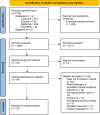The effect of cognitive behavioural therapy on pain and disability in chronic non-specific low back pain: An overview of systematic reviews
- PMID: 40526738
- PMCID: PMC12173195
- DOI: 10.1371/journal.pone.0325122
The effect of cognitive behavioural therapy on pain and disability in chronic non-specific low back pain: An overview of systematic reviews
Abstract
Background: Low back pain (LBP) is experienced by most people at least once in their lifetime and is the leading cause of disability worldwide. Cognitive behavioural therapy (CBT) is a non-invasive method used to manage chronic non-specific low back pain (CNSLBP) and contains less adverse effects than analgesic medications.
Aims: To determine the efficacy of interventions incorporating CBT on reducing pain intensity and physical disability in CNSLBP.
Methods: An overview of reviews without meta-analysis was conducted. Four electronic databases (MEDLINE, Embase, Cochrane Library and PsycINFO) were searched. Adults aged 18 or above with CNSLBP were included. AMSTAR 2 was used to assess risk of bias of included systematic reviews and data synthesis was conducted via vote counting methods.
Results: Ten systematic reviews were included. Results showed that CBT is more effective in reducing pain and disability compared to waiting list/usual care (WL/UC). CBT in conjunction with other active treatments (AT) are also more effective than some standalone AT such as physiotherapy and exercise, but less effective than surgery.
Conclusion: CBT has some effect in reducing pain and disability, however, it may not be more effective than other treatments. The quality of evidence was low for most outcomes as there was high risk of bias and heterogeneity between studies. Future research could evaluate specific therapies such as acceptance and commitment therapy (ACT) and mindfulness-based cognitive therapy (MBCT), as these treatments lacked primary studies. There is no recognised standard for conducting CBT, and further research could determine the most effective duration, mode of delivery (e.g., online, group-based) and intensity of CBT.
Copyright: © 2025 Leung et al. This is an open access article distributed under the terms of the Creative Commons Attribution License, which permits unrestricted use, distribution, and reproduction in any medium, provided the original author and source are credited.
Conflict of interest statement
The authors have declared that no competing interests exist.
References
-
- Krismer M, van Tulder M, Low Back Pain Group of the Bone and Joint Health Strategies for Europe Project. Strategies for prevention and management of musculoskeletal conditions. Low back pain (non-specific). Best Pract Res Clin Rheumatol. 2007;21(1):77–91. doi: 10.1016/j.berh.2006.08.004 - DOI - PubMed
-
- WHO. Low Back Pain: WHO; 2023. [updated 19/06/2023. Available from: https://www.who.int/news-room/fact-sheets/detail/low-back-pain.
Publication types
MeSH terms
LinkOut - more resources
Full Text Sources
Medical
Miscellaneous


